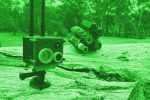
Affordable 3D Printed Thermal Fusion Night Vision Goggles with Raspberry Pi Processing
3dprintingindustry.com
Angus Logue, an engineer specializing in electrooptical systems, has developed the DNV Digital Thermal Fusion Night Vision Gogglesa helmetmounted system that overlays thermal imagery onto visible-light digital night vision in real time. Claimed to be the first affordable system of its kind, this device aims to enhance situational awareness for nocturnal wildlife observation and other low-light applications. A 264192 thermal sensor works in tandem with a low-light CMOS camera, while an integrated infrared spotlight supplements image capture. Early technical documentation emphasizes that this approach is not merely an incremental update but a fundamental shift in combining heat signatures with detailed visual information.DNV Digital Thermal Fusion Night Vision Goggles. Photo via Angus Logue.A key element in this project is the use of 3D printing to accelerate development and iterate design improvements. Rapid prototyping via FDM 3D printing allowed Logues to fabricate custom components for the helmet mounting and housing of the optical assembly. Such additive manufacturing techniques enabled precise integration of internal processing components with robust, waterproof enclosures. Molded silicone gaskets and other off-the-shelf assemblies ensured that prototypes could withstand harsh environmental conditions, a requirement for reliable field use.Assembly and wiring process of the DNV Digital Thermal Fusion Night Vision Goggles, featuring 3D printed components and integrated electronics. Photo via Angus Logue.Central to the devices performance is its reliance on an embedded computing platform built around a Raspberry Pi, a single-board computer renowned for its versatility in prototyping and low-power applications. Engineers optimized firmware to run efficiently on this platform, allowing real-time image fusion without imposing significant processing overhead. Custom camera firmware integrates digital magnification, image capture, and precise alignment of thermal and visible-light images.Rigorous testing protocols combined laboratory and field evaluations to assess performance across the infrared and thermal spectra. Iterative design cycles refined hardware integration, firmware efficiency, and ergonomic factors. Empirical data from these evaluations provided insights into trade-offs between image resolution and system portability, prompting further refinements in both sensor alignment and processing algorithms. Detailed assessments confirmed that blending thermal and digital imaging could yield a comprehensive picture in low-light environmentsa significant improvement over conventional monocular systems that often induce eye strain.Engineer Angus Logue setting up a field test for the DNV night vision system. Photo via Angus Logue.While claims of affordability remain subject to market comparisons, the DNV Digital Thermal Fusion Night Vision Goggles represent a substantial advance in cost-effective, portable imaging technology. Future development may focus on incorporating higher resolution sensors and more advanced processing capabilities to expand the devices applicability.A rendering of the DNV Digital Thermal Fusion Night Vision Goggles mounted on a helmet. Photo via Angus Logue.3D Printing for Rapid Prototyping and Modular Hardware IntegrationJames Bruton, a robotics engineer and former toy designer, developed an omni-directional ball-wheeled bike utilizing 3D printed structural components. The bikes housing and wheel support structures were fabricated using SLS 3D printing, allowing precise customization without expensive molds. Bruton employed PCB-based motor control systems to drive the wheel mechanisms, iterating on component placement and stability adjustments through rapid prototyping.Beth Le, a designer focusing on modular electronics, developed the Beth Deck, a handheld gaming device built from 3D printed components. The console integrates a Framework 13-inch laptop mainboard, a custom 3D printed housing, and an 8-inch touchscreen, enabling users to assemble or upgrade the system without soldering. The devices thermal performance required design modifications, leading to planned revisions for better airflow and reduced overheating in future iterations.Testing the omni-directional ball-wheeled bike. Image via James Bruton.Ready to discover who won the 20243D Printing Industry Awards?What will the future of 3D printing look like?Which recent trends are driving the 3D printing industry, as highlighted by experts?Subscribe to the 3D Printing Industry newsletter to stay updated with the latest news and insights.Stay connected with the latest in 3D printing by following us on Twitter and Facebook, and dont forget to subscribe to the 3D Printing Industry YouTube channel for more exclusive content.Featured image shows the DNV Digital Thermal Fusion Night Vision Goggles. Photo via Angus Logue.
0 Comentários
·0 Compartilhamentos
·55 Visualizações


